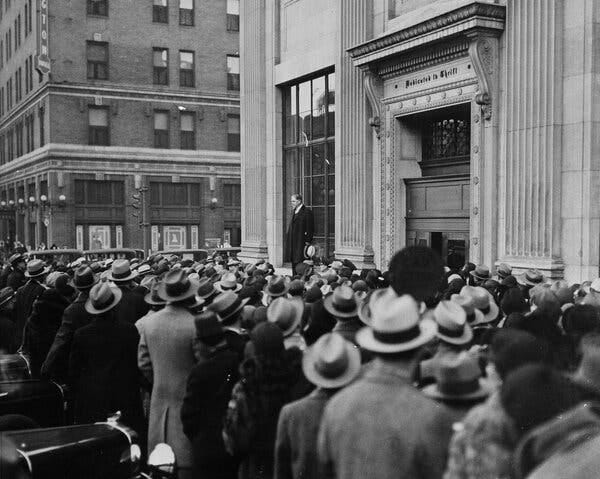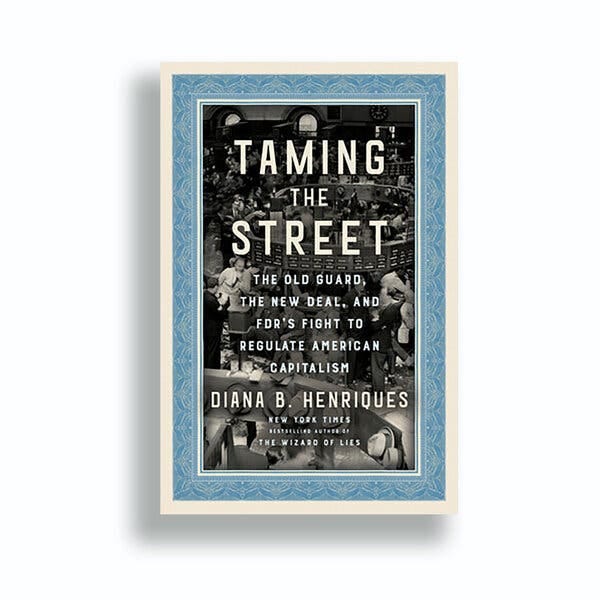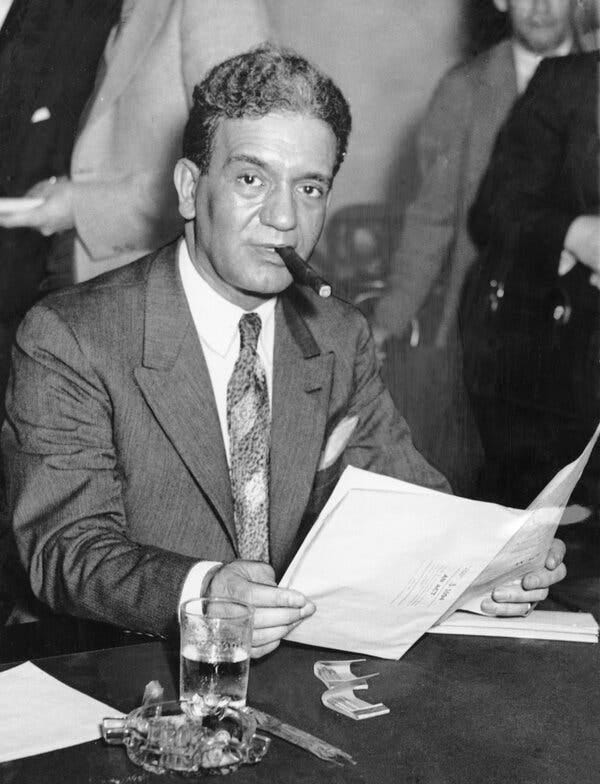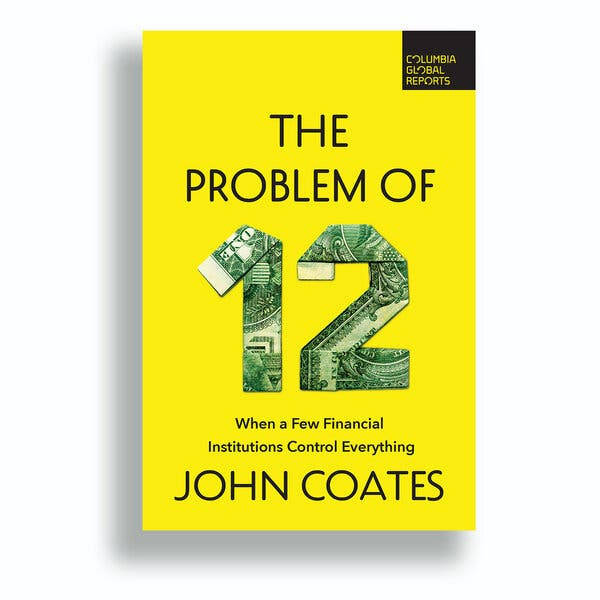Are Index Funds Making the Economy Less Fair?
By J. Bradford DeLong
Sept. 12, 2023, 5:00 a.m. ET
TAMING THE STREET: The Old Guard, the New Deal, and FDR’s Fight to Regulate American Capitalism, by Diana B. Henriques
THE PROBLEM OF TWELVE: When a Few Financial Institutions Control Everything, by John Coates
“The rulers of the exchange of mankind’s goods have failed, through their own stubbornness and their own incompetence,” President Franklin D. Roosevelt said at his first inaugural in 1933 as he kicked off his New Deal. “The money changers have fled from their high seats in the temple of our civilization. We may now restore that temple to the ancient truths.”
The direct reference to Matthew 21 and F.D.R.’s implication that he was going to do the work of the Lord in cleansing the temple of impiety were deliberate. The United States was suffering from the most virulent stage of the Great Depression. Key to the New Deal was regulation to try to make American finance work for the people and the economy, rather than for the plutocrats. Supporting Roosevelt in this crusade were overwhelming majorities in the House and Senate. What he and his team proposed, Congress would pass.
That’s not to say it was easy. In “Taming the Street,” the veteran financial journalist Diana B. Henriques tells the extraordinary story of how New Deal financial regulation was accomplished. It was indeed a feat of cleansing temples by driving out money changers. The Glass-Steagall Act of 1933 separated the investment bankers from the institutions with bank deposits; the Banking Act of 1935 strengthened the Federal Reserve’s independence by getting the Treasury Secretary out of the Chair’s seat.
The system the New Deal created was supposed to be impersonal in that no single individual’s thumb up or thumb down could make or break your business. In theory, you would always have a range of counterparties, and if you did not like one offer you could go down Wall Street or up Park Avenue and find someone else willing to offer you terms almost as good — or better.
The idea was that no one should find himself in the situation that the Chicago business magnate Samuel Insull and his admittedly overleveraged utility network did in the early 1930s, when J.P. Morgan Jr. had offered Insull an extortionist loan to save his Depression-stressed network from collapse and made it clear to other financiers that he would regard it as extremely unfriendly if they were to offer Insull another way out.
Henriques’s narrative is full of complex financial instruments and institutions. She has sweated gallons of blood to make it readable and succeeded by bringing her characters to life.
We hear about Ferdinand Pecora, the Sicilian-born attorney with “a distinctive curly black pompadour” who exposed the corruption and fraud of the old system in a series of dramatic Senate hearings. His findings inspired the reforms that the Roosevelt administration put in place. Through rigorous questioning and the judicious use of his subpoena power, Pecora uncovered the way Morgan and his friends in finance invited bankers and politicians to buy securities at special discounts with promises to find, as one Democratic Party official put it in a letter Pecora dug up, “opportunities for me to reciprocate.”
The New Deal would be an impersonal system and it would be a fair system. Nobody would find that his life was controlled by the decision of some financier 800 miles away. Instead, there would only be market prices transmitting resource scarcities and estimates of future demand and profitability that all could see, and all could decide to invest or not invest.
Those reforms broadly worked. Stock prices once again served as indicators, even if not perfect ones, of the companies that would be profitable, and hence, hopefully, serve the public good.
Yet, by the 1970s, people began to see the American economy as dominated by the big firms that had the most practice working the regulatory levers. Legislators sought to use the creative destruction of the market to make things more mobile again. To many — including me — the risks from loosening up the system seemed low: The Federal Reserve felt powerful enough to construct a firewall to keep financial chaos at bay.
Bit by bit, financial interests concentrated again. In the 21st century, the old trusts appear to be back, but in different garb. It’s a far more complicated and less sexy story to tell. Today, we have what the Harvard economist John Coates calls “The Problem of Twelve.” Coates’s book, an expansion of a scholarly paper from 2018, identifies only eight problems: the four index fund giants — Vanguard, Fidelity, State Street, BlackRock; and the four private-equity giants — Apollo, Blackstone, Carlyle, K.K.R. So why 12? It’s not clear. Perhaps we should add the four trillion-dollar banks: JPMorgan Chase, Bank of America, Citigroup, Wells Fargo. That makes 12.
A couple of decades ago, financiers at Vanguard and Fidelity convinced a whole generation of middle-class professionals that index funds — in which millions of small-time retail investors effectively put their money into tiny slivers of hundreds of stocks — were a safe, friendly way to make money off the good fortune of the overall economy. They were broadly right.
Then the funds grew. As Coates notes, the shares the four fund giants hold for their investors today amount to about one fifth of the stock shares across corporate America. That makes them quite powerful, especially because few index fund customers think about the corporate consequences of the decisions that fund managers make. Without public awareness, there is little incentive for politicians to act. Power without accountability, Coates argues, is always dangerous. And he is right.
“No longer do we have an economy controlled by thousands of executive managers of thousands of public companies, held in check by an array of dispersed governance institutions,” Coates writes. Instead, we have rule by index fund. In 2021, when Larry Fink, the C.E.O. of BlackRock, a $10 trillion fund, suggested that he expected the companies his firm invested in to go green in the near-term future, it helped three environmentally friendly executives win seats on the board of Exxon Mobil. Personally, I approve of this use of Fink’s power; we are a generation late to dealing with global warming. Still, checking the untrammeled individual influence of big financial institutions such as BlackRock was at the heart of F.D.R.’s New Deal.
Economists also worry that the overwhelming sway of index funds could be stifling price competition. You don’t need a fund’s anointed board members to sit across many boards in an industry where it is the largest shareholder for the C.E.O.s of, say, United Airlines and Delta, to get it in their heads that competing on routes might drive down prices and therefore stock value and that this might cause undesirable instability for the fund overall.
Now we should not overstate: None of the 12, not even in their particular sphere, even taken all together, has anything like the reach and power that the House of Morgan held over the U.S. economy a century and more ago. And yet it is undeniable that there are now an uncomfortably small number of uncomfortably large players in the fund-management and private-equity branches of American finance, in addition to our too-big-to-fail super big banks.
I found myself disappointed at the end of Coates’s book, when I began thinking I would get the “what I think we should do” message. Ideas about stewardship codes and antitrust remedies are not thoroughly worked out — as, indeed, they cannot be in a short book. I understand that Coates feels that he stands at the beginning of a reform process, that his role is to start a dialogue. So my complaint is not really about Coates, but about the world: We understand much less than we should about today’s money changers, as they do their business in the temple courtyard.
J. Bradford DeLong is a professor of economics at U.C. Berkeley, a former U.S. Treasury official and the author of “Slouching Towards Utopia: An Economic History of the Twentieth Century.”
TAMING THE STREET: The Old Guard, the New Deal, and FDR’s Fight to Regulate American Capitalism | By Diana B. Henriques | 431 pp. | Random House | $30
THE PROBLEM OF TWELVE: When a Few Financial Institutions Control Everything | By John Coates | 188 pp. | Columbia Global Reports | $17




